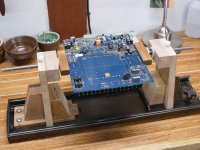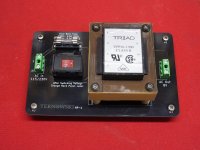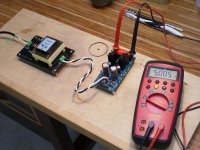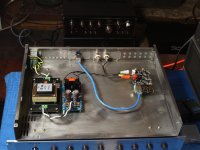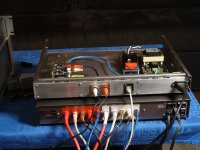Are those power pins the ones referred to in the Allo Boss manual to as 5V battery power connectors? Reading the manual, it appears that the Allo Boss should do a great job of "cleaning" the power that comes from the Pi, they even mention no need to contact extra power source to BOSS DAC[...].Here are some thoughts for your design consideration.
The Allo Boss has power pins to allow you to separately power it from the RPi. This will require another 5V regulator board should you choose to examine/test this configuration. Accordingly you will then have to re-lay your PCB for separate secondary windings instead of paralleling them to get two 8VAC outputs for your regulator. Lay it out so that the windings can be paralleled by a jumper on the board.
You can hard wire/solder power leads to the Rpi and the Allo Boss instead of using connectors/plugs. Use 22 or 24 ga wire.
I don't know... is it really worth the trouble to separately power Pi and DAC? I also don't feel too comfortable about de-soldering the R826 resistor on the DAC... the same goes for the Raspberry—while I could solder on the power wires directly, it would also make it more difficult to remove the Pi at a later point. I prefer the idea of having everything "pluggable", or connected with screw-terminals.
Thank you, very generous! I do have a whole lot of wire at home though, from 12 gauge 30AMP power cables to CAT6 ethernet and Mogami RCA/ Canare coax and lots of bits and pieces in between. I am sure I will find something suitable in that big box.I have some audio cable, 2 conductor shielded, 3.5mm black which I can send you for your build. It is new on a roll and I can take off 10ft. and send it to you. Send me a PM with your address.
See my comments above... I am just wondering if it's all worth it; after all, the Allo Boss was designed to filter the power as good as possible so that a separate PSU would not be possible, at least that's what they claim, isn't it?I agree with ktham; your project is currently so extensive that it would be a shame not to go just a bit further and accommodate a second 5V supply for the DAC-hat.
The DAC-hat deserves a high quality, low noise, such as the LT3042, ADM7150, or TPS7A4700 ...
but I see the BOSS DAC's onboard regulators are LT3042 - OK, in that case I would exclude LT3042 from your choice of pre-regulators, because by combining two different regulator types your get to reduce two different noise bandwidths.
ADM7150 and TPS7A4700 regulator kits can be found at diyinhk. You could also try eBay and AliExpress, with some price versus quality considerations.
Regarding the transformer, sure, you could split your Triad's secondaries to supply two regulators, but it seems to me that you have plenty of space in your enclosure, so I would use a second (smaller) transformer for the DAC-hat. Something like this Hammond -
229A16 - Hammond Mfg.
8VAC 700mA 48x40x22mm
or if you're more comfortable with a higher current rating, the next size up is
229B16 - Hammond Mfg.
8VAC 1.4A 64x51x27mm
One idea that was brought to my attention is, why go through the trouble designing an "AC board", but then using a separate regulator board. I could as well just design one board for both... it would be more challenging, but I like the idea. I already have the regulator parts, so in theory I would only need to put them onto my AC board design... oh well... maybe everything is becoming more complicated than it has to be?
Well ALLO has a good reputation for power filtration, but I can't help thinking that a dedicated high quality power supply to the DAC is best practice, especially since you are already going to a lot of effort with transformers, regulators, chassis etc.
If I was doing this project, I would maybe go even further and bypass the DAC's input power filters, inserting my own clean 5V power further downstream! Of course, this means brandishing a solder iron to the BOSS DAC, with corresponding risks.
The question at stake is does a separate power feed to the DAC-hat have an audible benefit? Only someone who has tried this will know - ktham might be able to say?
Here's a complete solution for you - LT3083 regulator with onboard transformer (the 12 watt Version is 2A @ 5VDC)
K&K Audio | Other kits
This regulator has better specs than the LD/LT/LM1085 regulators.
If I was doing this project, I would maybe go even further and bypass the DAC's input power filters, inserting my own clean 5V power further downstream! Of course, this means brandishing a solder iron to the BOSS DAC, with corresponding risks.
The question at stake is does a separate power feed to the DAC-hat have an audible benefit? Only someone who has tried this will know - ktham might be able to say?
Yes, but the regulator board you have chosen is a commercial product. Will you copy its layout? Or will you design your own LD1085-based regulator circuit?why go through the trouble designing an "AC board", but then using a separate regulator board. I could as well just design one board for both.
Here's a complete solution for you - LT3083 regulator with onboard transformer (the 12 watt Version is 2A @ 5VDC)
K&K Audio | Other kits
This regulator has better specs than the LD/LT/LM1085 regulators.
New DAC from Allo ess9028q2m for RPI
Check out this Allo news item on their existing Boss and the replacement. Maybe you should wait for this new model and see how it will integrate with your current design objectives/build. I will be ordering one when available.
I use Molex connector pins on my power leads so disconnecting is not an issue for me. I do not have faith in the Rpi power connectors. On all my builds I will over engineer those areas I think will be problematic based on my experience.
Try and build as much flexibility into your design because as you evaluate your build during listening tests you can be sure the tweak itch is going to bite you as you look for that ultimate sound that is unique to you.
Are you going to connect your RPi using WiFi or Ethernet to your music server? You will need to address this in your case layout.
Check out this Allo news item on their existing Boss and the replacement. Maybe you should wait for this new model and see how it will integrate with your current design objectives/build. I will be ordering one when available.
I use Molex connector pins on my power leads so disconnecting is not an issue for me. I do not have faith in the Rpi power connectors. On all my builds I will over engineer those areas I think will be problematic based on my experience.
Try and build as much flexibility into your design because as you evaluate your build during listening tests you can be sure the tweak itch is going to bite you as you look for that ultimate sound that is unique to you.
Are you going to connect your RPi using WiFi or Ethernet to your music server? You will need to address this in your case layout.
I don't know yet... I already have the GlassWare regulator, so if I don't use the board that came with it (which looks really nice, by the way), I could potentially copy the design to a board that includes the transformer. Since this is for my own personal project, I don't think I'd be in trouble doing that (I bought it after all... just changing the color of the car...)[...] Yes, but the regulator board you have chosen is a commercial product. Will you copy its layout? Or will you design your own LD1085-based regulator circuit?
Looks good; I remember K&K from when I explored SUT kits. But as I said, I already have the GlassWare regulator; in fact, I also already have the transformer etc. for the AC part of the PSU.Here's a complete solution for you - LT3083 regulator with onboard
transformer (the 12 watt Version is 2A @ 5VDC)
K&K Audio | Other kits
This regulator has better specs than the LD/LT/LM1085 regulators.
Hmmm.... just ordered the Allo Boss yesterday!New DAC from Allo ess9028q2m for RPI
Check out this Allo news item on their existing Boss and the replacement. Maybe you should wait for this new model and see how it will integrate with your current design objectives/build. I will be ordering one when available.
I think that is the key to this project. I will definitely leave it as flexible as possible, so that I can change the DAC or power supply etc. if I decide to later on. Thankfully I am going to use a huge case...Try and build as much flexibility into your design because as you evaluate your build during listening tests you can be sure the tweak itch is going to bite you as you look for that ultimate sound that is unique to you.
Are you going to connect your RPi using WiFi or Ethernet to your music server? You will need to address this in your case layout.
Ethernet. I got a nice RJ45 connector from Switchcraft, just arrived today. Along with a couple of Canare RCA panel mounts.
For the most part I am ready to start putting the electronics together. I will spend some time on the case design, and try to make up my mind what exactly to do with the PSU part.
On a side note: I build a PCB board holder today, came out pretty nice, no wobbling, everything sits tight, up to 9" in width. All made from recycled parts (old printer, keyboard mount, wood).
I'll keep you posted!
Attachments
Would the Glassware LV-regulator work with a transformer set up with dual secondaries as long as the supplied voltage and current are correct?
My response assumes that you are asking about dual secondaries in parallel and identical in voltage to feed the LV regulator. Short answer is yes.
The designer's recommendation is that the output current be no more than 2A so your transformer need not be oversized. You can size the transformer accordingly by paralleling the outputs. Just be careful how you parallel the secondaries when connecting them as there is definite protocol to observe. The transformer manufacture will have identified this in their documentation and on the transformer itself.
There is enough flexibility in the board layout for those who want to do some tweaking for their own specific build needs. Some information is covered in part in the User Guide supplied with the kit. Remember the warranty.
Well for the 5V LV-Regulator I could get the same one that drtebi got to power an Odroid C2. I was looking at an LV-Regulator for 12V power for a preamp board and an arduino which should together be around 2A. I have another 7V to 8V regulated supply (salas SSLV) to power which will be powering the isolated side of Ian's Isolator Pi, Kali reclocker board, and the isolated side of a Dam-1021 DAC. Since I need a 15Vac for the Salas SSLV, and most likely 15VAC for the Lv-Regulator could I use a dual 15VAC transformer to power both? Or would it be better to just get two smaller transformers and parallel the secondaries. Just trying to eliminate a transformer, since if I split them I have 4 transformers in the enclosure.
Yes you can use a dual output 15VAC to power the LV Regulator and the Salas where each one is an individual/independent circuit as stated. You can get the same effect by using two smaller transformers. Just remember to specify the output voltage desired when you order the LV Regulator as this will require different a resistor value and capacitor voltage value from the supplier. I am not familiar with the Salas.
If you look at the thumbnail in Post 59 I use three dual winding transformers for powering 6 different devices. Two are for my Pi/HAT/DAC/Kali combos and one is for +/- 15VDC. My builds use common elements wherever possible for flexibility and redundancy. Buy once and reuse as required.
If you look at the thumbnail in Post 59 I use three dual winding transformers for powering 6 different devices. Two are for my Pi/HAT/DAC/Kali combos and one is for +/- 15VDC. My builds use common elements wherever possible for flexibility and redundancy. Buy once and reuse as required.
The transformer I chose is a PCB mounted transformer, so you need a PCB to go with it. Just wanted to point that out.Well for the 5V LV-Regulator I could get the same one that drtebi got to power an Odroid C2.
I only chose that particular one because I needed something very flat... since my case is only 2.25 inches high on the inside.
You shouldn't have a problem finding a transformer with the same specs but without the need to mount to a PCB. Unless, of course, that is what you want...
A41-25-16 Bel Signal Transformer | Mouser
How does this work for a chassis mount version of the one drtebi used?
How does this work for a chassis mount version of the one drtebi used?
Looking at the requirements for the LV Regulator, the transformer meets the requirements for 8 VAC output and 25VA.
You can use one secondary winding for the Rpi and the other for the kali reclocker. Your best bet is to find out the current consumption of all your devices and add them up so that the transformer can be sized accordingly. Of course you will need a second LV Regulator.
I use 35VA transformers for my builds because the current requirements keep increasing with every new iteration of HAT DACs and new models and I am tired of drilling holes.
You can use one secondary winding for the Rpi and the other for the kali reclocker. Your best bet is to find out the current consumption of all your devices and add them up so that the transformer can be sized accordingly. Of course you will need a second LV Regulator.
I use 35VA transformers for my builds because the current requirements keep increasing with every new iteration of HAT DACs and new models and I am tired of drilling holes.
A little update...
I got the PCB board (from PCBWay) and all parts, soldered it together. Also got the LV Regulator and put it together. Everything went pretty flawlessly. Just tested the PSU today with the multimeter, and I am getting 5.005V DC. Looks like it worked out!
Next step will be to put this all into a case and connect the raspberry pi. I want to run it and check the temperature of the regulator/heat-sink, to make sure it is not running too hot.
For now I will just use an old pre-amp case that I have. It's the same size as the Sony Pre-Esprit components, so maybe I will end up just changing the front panel, if that works out somehow... we'll see.
Attached a couple of pictures.
P.S.: I have two extra "transformer" boards. If anyone is interested, I could provide these. The same parts would obviously have to be used, all available from Digikey.
I got the PCB board (from PCBWay) and all parts, soldered it together. Also got the LV Regulator and put it together. Everything went pretty flawlessly. Just tested the PSU today with the multimeter, and I am getting 5.005V DC. Looks like it worked out!
Next step will be to put this all into a case and connect the raspberry pi. I want to run it and check the temperature of the regulator/heat-sink, to make sure it is not running too hot.
For now I will just use an old pre-amp case that I have. It's the same size as the Sony Pre-Esprit components, so maybe I will end up just changing the front panel, if that works out somehow... we'll see.
Attached a couple of pictures.
P.S.: I have two extra "transformer" boards. If anyone is interested, I could provide these. The same parts would obviously have to be used, all available from Digikey.
Attachments
A little update...
I got the PCB board (from PCBWay) and all parts, soldered it together. Also got the LV Regulator and put it together. Everything went pretty flawlessly. Just tested the PSU today with the multimeter, and I am getting 5.005V DC. Looks like it worked out!
Next step will be to put this all into a case and connect the raspberry pi. I want to run it and check the temperature of the regulator/heat-sink, to make sure it is not running too hot.
For now I will just use an old pre-amp case that I have. It's the same size as the Sony Pre-Esprit components, so maybe I will end up just changing the front panel, if that works out somehow... we'll see.
Attached a couple of pictures.
P.S.: I have two extra "transformer" boards. If anyone is interested, I could provide these. The same parts would obviously have to be used, all available from Digikey.
Please tell us what was the effect on the sound of the RPI after using this supply.
A basic question:
I understand that it is important to feed clean power to the Boss DAC, because its circuit will then not be affected by ripple / EMI / etc, and will operate free from line noise.
But is it necessary to regulate the voltage also? I mean, is the DAC sensitive to even small fluctuations (say 5V +-10%) in the line voltage? IMHO the regulator may add its own bit of noise to the outgoing power.
I understand that it is important to feed clean power to the Boss DAC, because its circuit will then not be affected by ripple / EMI / etc, and will operate free from line noise.
But is it necessary to regulate the voltage also? I mean, is the DAC sensitive to even small fluctuations (say 5V +-10%) in the line voltage? IMHO the regulator may add its own bit of noise to the outgoing power.
I'll be honest with you:
I haven't noticed a difference. Or, better said, I don't know. Maybe I would, if I could do a direct A/B comparison. But since I only have one Rpi, that's currently not possible.
Maybe I am just too old school to use a switching power supply to build a Rpi streamer. A linear power supply also looks better And it was fun to put it together...
And it was fun to put it together...
So in summary I would say try it yourself, maybe you can do an A/B setup, and decide for yourself if it is worth it.
I haven't noticed a difference. Or, better said, I don't know. Maybe I would, if I could do a direct A/B comparison. But since I only have one Rpi, that's currently not possible.
Maybe I am just too old school to use a switching power supply to build a Rpi streamer. A linear power supply also looks better
So in summary I would say try it yourself, maybe you can do an A/B setup, and decide for yourself if it is worth it.
Last edited:
I'll be honest with you:
I haven't noticed a difference. Or, better said, I don't know. Maybe I would, if I could do a direct A/B comparison. But since I only have one Rpi, that's currently not possible.
Maybe I am just too old school to use a switching power supply to build a Rpi streamer. A linear power supply also looks betterAnd it was fun to put it together...
So in summary I would say try it yourself, maybe you can do an A/B setup, and decide for yourself if it is worth it.
I had bought a new IFI 5V power adapter and was running the RPi + Boss + 7in Touchscreen with this supply. The power was fed to the RPi; the Boss got power from the HAT connection, the 7inLCD got its power from the USB connection to the RPi. I was seeing the yellow bolt icon all the time, which meant that the RPi was not getting enough voltage.
So I connected the Allo PSU adapter to the LCD, and the IFI PSU to the RPi. What I lost was the touchscreen functions of the LCD. What I gained was that the yellow icon vanished, meaning that the RPi got adequate voltage. The SQ became a tad clearer. So definitely, PSU voltage was important.
Between the Allo and IFI, my observation was that the latter resulted in clearer sound, for sure. PS filtering does have a big effect.
If you have a device which draws 2.5A @ 5V (and the Raspberry Pi draws nowhere near that much current) that's a 12.5 VA output requirement.
Also note that 2.5A exceeds the recommended current limit of the Glassware regulator.
I would expect the GlassWare regulator, fed by 8VAC to have an efficiency of less than 50%. To overcome this power loss, the transformer needs to be more than double that 12.5 VA. 30 VA would be barely adequate - 40VA or 50VA would be a more realistic bare minimum transformer requirement. And if we're talking about a device which continuously draws 2.5A @ 5V, I would be inclined to double that value again.
But are we really talking about the Raspberry Pi here? The rPi 3 working flat out draws less than 800mA, in which case the 30VA transformer being used by drtebi (Triad VPP16-1900) is more than adequate.
Also note that 2.5A exceeds the recommended current limit of the Glassware regulator.
I would expect the GlassWare regulator, fed by 8VAC to have an efficiency of less than 50%. To overcome this power loss, the transformer needs to be more than double that 12.5 VA. 30 VA would be barely adequate - 40VA or 50VA would be a more realistic bare minimum transformer requirement. And if we're talking about a device which continuously draws 2.5A @ 5V, I would be inclined to double that value again.
But are we really talking about the Raspberry Pi here? The rPi 3 working flat out draws less than 800mA, in which case the 30VA transformer being used by drtebi (Triad VPP16-1900) is more than adequate.
- Status
- This old topic is closed. If you want to reopen this topic, contact a moderator using the "Report Post" button.
- Home
- Amplifiers
- Power Supplies
- Linear PSU for Raspberry Pi 3, which one? Confused.
